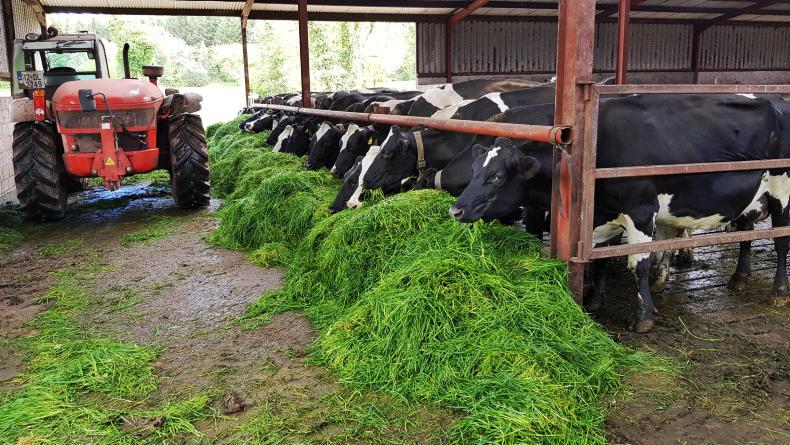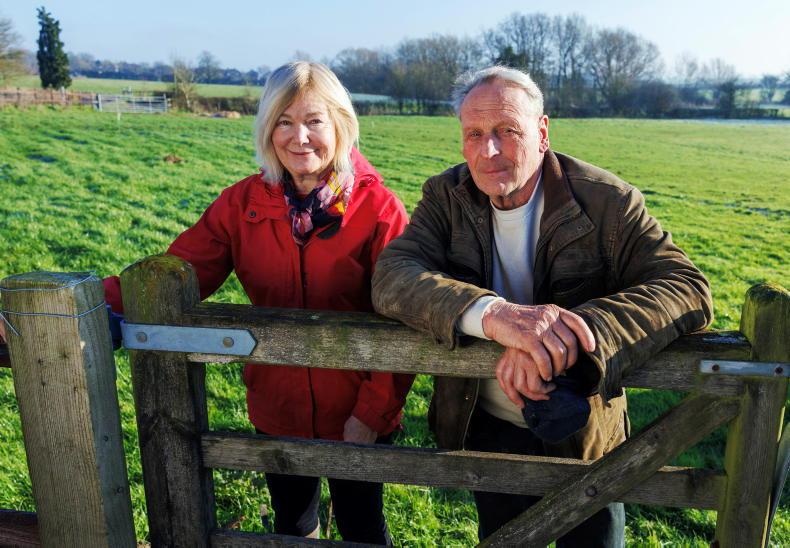This is the first full season of measuring grass for each of the six farmers who joined Dairylink Ireland as part of the second phase of the programme last autumn. With grass growth increasing during May, the benefits of basing grassland management decisions on information from weekly farm walks is now being seen.
Dairylink adviser Conail Keown says grass growth on most programme farms was around 50kgDM/ha/day at the start of the month. This was lower than the 75kgDM/ha/day usually seen in early May, although growth has increased with the arrival of warmer weather last weekend.
Programme farmers are being encouraged to monitor pre- and post-grazing covers closely and take paddocks that have covers over 1,900kgDM/ha (utilisable) out for silage. “The focus should be to keep top-quality grass in front of cows. Skipping paddocks ensures the herd moves on to the best-quality grass on the farm,” Conail said.
Based on a stocking rate of 4.0-4.5LU/ha, Conail said average cover on Dairylink farms needs to be around 800kgDM/ha at present. This will give an average available cover per cow of 175-200kgDM/ha.
Examples
Grass measurement on Richard Marshall’s farm near Omagh last week highlighted a deficit on the milking platform because some of the grazing block was cut for silage along with first cut last week. This left milking platform stocking rate over 5.0LU/ha and cover per cow is below target at 125kgDM/ha. To address the issue, a batch of 35 high-yielding cows will remain inside this week so that there is no additional demand on grass. Growth should improve with warmer weather this week and Richard will measure again next week to re-assess the situation.
Phase one participant Nigel Corbett has a well-established grass wedge on his farm near Banbridge. The highest pre-grazing covers are around 1,600kgDM/ha and cleanouts are good, with post-grazing covers around 300kgDM/ha.
Nigel is taking maintenance plus 20 litres from grass and average cover per cow is on target at 180kgDM/ha. One paddock is currently out of the rotation and will be cut for bales. Nigel will make a decision on skipping another paddock after a grass walk later this week.
Farmer focus: Robin Clements, Trillick, Co Tyrone
The high-yielding group of 65 cows is housed and is on zero-grazed grass on Dairylink phase one participant Robin Clements’ farm near Trillick. There is a limited land area around the yard for grazing (40ha) so zero grazing allows grass from an outlying block to support extra cows in the autumn-calving herd.
The zero-grazed cows are fed concentrates through in-parlour feeders and are on 2.5kg/cow/day on average at present. There are 110 cows at grass, with 1kg/cow/day fed to this group. Overall the herd is averaging 20 litres/cow/day at present and the first cows will be due for drying off in six weeks.

Robin cut and baled 90 acres of first-cut at the end of last week.
It was an ideal spring weather-wise on the Clements’ farm. The first cows got out to grass in early March and Robin notes that grass growth and utilisation for the most part have been excellent so far this year.
A grass walk on Monday showed growth on the grazing block at 57kgDM/ha/day and average cover was 900kgDM/ha. The zero-grazed group gives Robin plenty of flexibility to alter milking platform stocking rate in line with growth rates. For example, more cows can join the grazing group as grass growth improves and surplus grass on the outlying block can be cut for bales.
First-cut silage was mowed at the weekend, with 80 acres baled at the start of the week in ideal conditions. There is no clamp silage made on the Clements’ farm and all machinery work is done by Robin and his sons Stephen and Matthew.
TB issue
The herd had a TB breakdown in June 2018 and is still closed up at present. Robin had a clear herd test last month and will be able to sell stock again if he has no reactors at the next herd test later this summer.
It has meant all calves from the 2018 calving season are still on the farm. Robin has 50 heifer calves for replacements and 50 black and white bull calves are being intensively fed for finishing at 10 months as part of a rose veal contract. This allows the bull calves to place no demand on grass and means they will be off the farm by the time the 2019 calving season starts in the autumn.
The remaining calves from 2018 are sired by Angus, Hereford and Belgian Blue bulls. They are at grass at present and will be sold once the herd is clear from TB.
Weekly round-up
Grassland management decisions are based on figures from grass measurement on Dairylink farms.Figures from grass covers are in terms of utilisable cover which are calculated by subtracting 1,500kgDM/ha from total cover.Dairylink farmers are skipping over paddocks with more than 1,900kgDM/ha to keep cows on the best quality grass.Some programme farmers are getting maintenance plus 20 litres/cow/day from grazed grass at present. Read more
Watch: Dairylink – early first-cut silage made in Tyrone
Dairylink: getting more from grass in Tyrone
This is the first full season of measuring grass for each of the six farmers who joined Dairylink Ireland as part of the second phase of the programme last autumn. With grass growth increasing during May, the benefits of basing grassland management decisions on information from weekly farm walks is now being seen.
Dairylink adviser Conail Keown says grass growth on most programme farms was around 50kgDM/ha/day at the start of the month. This was lower than the 75kgDM/ha/day usually seen in early May, although growth has increased with the arrival of warmer weather last weekend.
Programme farmers are being encouraged to monitor pre- and post-grazing covers closely and take paddocks that have covers over 1,900kgDM/ha (utilisable) out for silage. “The focus should be to keep top-quality grass in front of cows. Skipping paddocks ensures the herd moves on to the best-quality grass on the farm,” Conail said.
Based on a stocking rate of 4.0-4.5LU/ha, Conail said average cover on Dairylink farms needs to be around 800kgDM/ha at present. This will give an average available cover per cow of 175-200kgDM/ha.
Examples
Grass measurement on Richard Marshall’s farm near Omagh last week highlighted a deficit on the milking platform because some of the grazing block was cut for silage along with first cut last week. This left milking platform stocking rate over 5.0LU/ha and cover per cow is below target at 125kgDM/ha. To address the issue, a batch of 35 high-yielding cows will remain inside this week so that there is no additional demand on grass. Growth should improve with warmer weather this week and Richard will measure again next week to re-assess the situation.
Phase one participant Nigel Corbett has a well-established grass wedge on his farm near Banbridge. The highest pre-grazing covers are around 1,600kgDM/ha and cleanouts are good, with post-grazing covers around 300kgDM/ha.
Nigel is taking maintenance plus 20 litres from grass and average cover per cow is on target at 180kgDM/ha. One paddock is currently out of the rotation and will be cut for bales. Nigel will make a decision on skipping another paddock after a grass walk later this week.
Farmer focus: Robin Clements, Trillick, Co Tyrone
The high-yielding group of 65 cows is housed and is on zero-grazed grass on Dairylink phase one participant Robin Clements’ farm near Trillick. There is a limited land area around the yard for grazing (40ha) so zero grazing allows grass from an outlying block to support extra cows in the autumn-calving herd.
The zero-grazed cows are fed concentrates through in-parlour feeders and are on 2.5kg/cow/day on average at present. There are 110 cows at grass, with 1kg/cow/day fed to this group. Overall the herd is averaging 20 litres/cow/day at present and the first cows will be due for drying off in six weeks.

Robin cut and baled 90 acres of first-cut at the end of last week.
It was an ideal spring weather-wise on the Clements’ farm. The first cows got out to grass in early March and Robin notes that grass growth and utilisation for the most part have been excellent so far this year.
A grass walk on Monday showed growth on the grazing block at 57kgDM/ha/day and average cover was 900kgDM/ha. The zero-grazed group gives Robin plenty of flexibility to alter milking platform stocking rate in line with growth rates. For example, more cows can join the grazing group as grass growth improves and surplus grass on the outlying block can be cut for bales.
First-cut silage was mowed at the weekend, with 80 acres baled at the start of the week in ideal conditions. There is no clamp silage made on the Clements’ farm and all machinery work is done by Robin and his sons Stephen and Matthew.
TB issue
The herd had a TB breakdown in June 2018 and is still closed up at present. Robin had a clear herd test last month and will be able to sell stock again if he has no reactors at the next herd test later this summer.
It has meant all calves from the 2018 calving season are still on the farm. Robin has 50 heifer calves for replacements and 50 black and white bull calves are being intensively fed for finishing at 10 months as part of a rose veal contract. This allows the bull calves to place no demand on grass and means they will be off the farm by the time the 2019 calving season starts in the autumn.
The remaining calves from 2018 are sired by Angus, Hereford and Belgian Blue bulls. They are at grass at present and will be sold once the herd is clear from TB.
Weekly round-up
Grassland management decisions are based on figures from grass measurement on Dairylink farms.Figures from grass covers are in terms of utilisable cover which are calculated by subtracting 1,500kgDM/ha from total cover.Dairylink farmers are skipping over paddocks with more than 1,900kgDM/ha to keep cows on the best quality grass.Some programme farmers are getting maintenance plus 20 litres/cow/day from grazed grass at present. Read more
Watch: Dairylink – early first-cut silage made in Tyrone
Dairylink: getting more from grass in Tyrone











SHARING OPTIONS